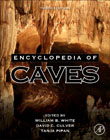
Encyclopedia of Caves, Third Edition, provides detailed background information to anyone with a serious interest in caves. This includes students, both undergraduate and graduate, in the earth, biological and environmental sciences, and consultants, environmental scientists, land managers and government agency staff whose work requires them to know something about caves and the biota that inhabit them. Caves touch on many scientific interests in geology, climate science, biology, hydrology, archaeology, and paleontology, as well as more popular interests in sport caving and cave exploration. Case studies and descriptions of specific caves selected for their special features and public interest are also included. This book will appeal to these audiences by providing in-depth essays written by expert authors chosen for their expertise in their assigned subject. Features 14 new chapters and 13 completely rewritten chaptersContains beautifully illustrated content, with more than 500 color images of cave life and featuresProvides extensive bibliographies that allow readers to access their subject of interest in greater depth INDICE: Adaptation to low food; Adaptation: darkness; Adaptation: Low oxygen; Adaptation: Overview of natural selection; Adaptations: Behavioral; Adaptations: Morphological; Adaptive shifts; Anchialine caves; Ancient caves in eastern North America; Asellus aquaticus: A model organism; Astyanaxs mexicanus: A model organism for evolution and adaptation; Bats; Beetles; Biodiversity: Australia; Biodiversity: Europe; Biodiversity: North America; Biodiversity: Tropics; Breakdown; Burnsville Cove caves, Virginia; Camps; Castleguard Cave, Canada; Cave dwellers in the Middle East; Cave ecosystems; Cave, definition of Cavefish; Caves as geomorphic time markers; Caves of northern Laos; Chemoautotrophy; Clastic sediments in caves; Closed depressions in karst areas; Coastal caves; Collembola, Dilura, and Thysanura; Contamination of cave waters by heavy metals; Contamination of cave waters by nonaqueous phase liquids; Cosmogenic isotope dating of cave sediments; Crustacea; Dinaric karst: geography and geology; Documentation and databases; Ecological classification of subterranean organisms; Entrances; Epikarst; Epikarst communities; Exploration of caves - general; Exploration of caves: Underwater exploration techniques; Exploration of caves: Vertical caving techniques; Folklore, myth and legend, caves in; Food sources; Frassassi Caves, Italy; Geophysics of locating karst and caves; Glacier caves; Guano communities; Gypsum caves; Gypsum flowers and related speleothems; Hang Son Doong, Vietnam; Helictites and related speleothems; Holloch Cave, Switzerland; Hydrogeology of karst aquifers; Hydrothermal caves; Ice in caves; Iron ore caves and their fauna; Jewel Cave, South Dakota; Karren, cave; Karren, surface; Karst; Kazumura Cave, Hawaii; Krubera (Voronja) Cave; Lampenflora; Lechuguilla Cave, New Mexico; Life history evolution; Mammoth Cave system Kentucky; Mapping subterranean biodiversity; Maya caves; Microbes; Minerals in caves; Model species for evolution and adaptation; Modeling of karst aquifers; Mollusks; Multilevel caves and landscape evolution; Mulu Caves, Malaysia; Myriapods; Niphargus: A model organism for evolution and ecology; Nitrate contamination in karst groundwater; Nullarbor Caves, Australia; Omega System, Virginia; Orthoptera; Paleoclimate records from speleothems; Paleomagnetic records in cave sediments; Paleontology of caves; Passage growth and development; Pierre Saint-Martin System, France; Postojna Planina Cave System, Slovenia; Protecting cave life; Protecting caves; Quartzite caves of South America; Recreational caving; Relict species; Rescues; Salamanders; Saltpetre mining; San Wang Dong and related caves, China; Scallops; Shallow subterranean habitats; Show caves; Siebenhengste Cave System, Switzerland; Sistema Huautla, Mexico; Soil piping and sinkhole failures; Solution caves in regions of high relief; Solution caves in regions of moderate relief; Species interactions; Speleogenesis: hypogenic; Speleogenesis; telogenic; Speleothems and speleothem deposition; Spiders and related groups; Springs; Sulfuric acid caves; Tiankeng; Ukraine giant gypsum caves; Underwater caves of the Yucatan Peninsula; Uranium series dating of speleothems; Vertebrate visitors and unspecialized residents; Vicariance and dispersal; Vjetrenica Cave, Bosnia & Hercegovina; Volcanic rock caves; Walkulla Spring underwater cave system; Water chemistry in caves; Water tracing in karst aquifers; Wetlands in cave and karst regions; White-Nose syndrome: a fungal disease of North American hibernating bats; Worms
- ISBN: 978-0-12-814124-3
- Editorial: Academic Press
- Encuadernacion: Rústica
- Páginas: 1100
- Fecha Publicación: 01/03/2019
- Nº Volúmenes: 1
- Idioma: Inglés
